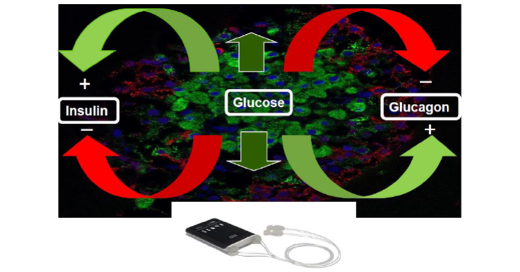Dual-hormone artificial pancreas systems use insulin and glucagon to control glucose in patients with diabetes - a dream is about to come true
Insulin-only closed-loop AP systems hold promise for reducing the burden of diabetes self-management, but there is still potential for improvement regarding both hypoglycemia and hyperglycemia. A dual-hormone AP system achieves closed–loop glycemic control by subcutaneous infusion of insulin and of glucagon in response to glucose values detected by a continuous glucose monitoring device mimicking the physiological pattern of insulin and glucagon secretion of a healthy pancreas more closely than an insulin infusion-only system.
To reverse the insulin action when blood glucose shows a tendency to fall, glucagon is given as mini-boluses to prevent and to treat any imminent hypoglycemia [1]. Glucagon leads to a rapid conversion of hepatic glycogen (the stored form of glucose) into glucose which is then released into the bloodstream. The comprehensive technology of control algorithms and hardware and the development of long-term stable glucagon formulations have so far provided some development challenges.

The development progress
The major step forward made in the last five years was moving the evaluation of AP systems from highly controlled experimental conditions to daily life conditions at the patient’s home. Various academic working groups have demonstrated short-term efficacy and safety of automated insulin and glucagon delivery among people with type 1 diabetes mellitus [2, 3, 4, 5, 6]. It was shown that relative to conventional and sensor-augmented insulin pump therapy, the dual-hormone AP system, was able to achieve superior glycemic regulation without the need for carbohydrate counting [7]. A published systematic review indicated that dual-hormone AP systems were associated with a greater improvement in time in target range compared with single-hormone systems and showed lower heterogeneity in their studies [8]. Furthermore, it was shown that the addition of mini-doses of glucagon to the AP system resulted in more time in normal range and fewer events of hypoglycemia after continuous and interval exercise [9] and was more effective in preventing hypoglycemia than the suspension of insulin delivery alone after automated exercise detection [10]. Moreover, a dual-hormone closed-loop system is probably able to reduce postprandial hyperglycemia and to prevent hypoglycemia in the event of errors in meal carbohydrate counting [11, 12]. Although the additional use of glucagon increases system and cost complexity, glucagon’s effects on reducing caloric intake by counteracting insulin action and on increasing energy expenditure independently of brown adipose tissue thermogenesis seem to be advantageous within the context of the growing prevalence of overweight and obesity [13, 14].
Technological progress of AP closed-loop systems
Future continuous glucose monitoring devices will be smaller and wearable for a longer period of time [15], require less calibrations and offer improved glycemic reading accuracy during hypo- and hyperglycemia and reduced lag-time of continuous glucose monitoring as well as self-learning adapting algorithms [16, 17]. AP platforms have been developed that establish the communication between the commercially available continuous glucose monitors and insulin pumps and run the software algorithms [18]. Academic long-term trials of a bihormonal system are under way (e.g. iLetsystem/Boston, United States) designed to be the potential last steps for regulatory approval of this system. Glycemia and hormonal infusions data will probably be accessible for users via a mobile device and their health care professionals through a web platform.
The dual hormones insulin and glucagon-what about the near future?
From a controlling perspective, major challenges are that currently available rapid-acting insulin analogues still have relatively slow absorption after subcutaneous injection, and the poor stability of currently available glucagon formulations [19]. The development of even faster acting insulin with a faster onset and a shorter duration of action may optimize the use in AP closed-loop systems.
Native glucagon is a highly unstable peptide prone to spontaneous polymerization and formation of amyloid-like fibrils after reconstitution [20]. As glucagon was initially commercialized for one-time use as rescue medication for severe hypoglycemia, these formulations have to be used immediately after reconstitution [21, 22]. Stability data over 24 hours has only been available quite recently which, however, still means that daily glucagon renewal is required in a dual hormone chamber pump [23].
To face stability issues the recent glucagon research has focused on stable soluble glucagon formulations that will maintain long-term in-use stability and compatibility [24, 25]. Data from phase II and III clinical trials have been provided by both Zealand Pharma A/S and Xeris Pharmaceuticals [26] demonstrating safety and efficacy of their formulations. Food and Drug Administration (FDA) filing for Xeris’ Hypopen for severe hypoglycemia was announced last year. Profil has been involved in the research on Zealand’s stable soluble aqueous glucagon analogue (dasiglucagon) developed as recue treatment for severe hypoglycemia (Hypopal) [27] and for use in dual-hormone pump [28]. Promising large-scale phase III data of Zealand`s Hypopal will be presented at American Diabetes Association 79th Scientific Session (ADA) [29]. Up to now, only one feasibility trial has been published with Zealand’s dasiglucagon delivered by a closed-loop AP system (Beta Bionics, Boston, Massachusetts) indicating that glycemic responses were similar to those of native glucagon under fasting conditions using high insulin exposures, combined with structured exercise [30]. Zealand Pharma is currently working with Beta Bionics on a next-generation dual-hormone artificial pancreas device with built-in algorithm. The first home-use study has been initiated. Approval of the bihormonal version is still targeted for 2022.
Prospects
While these first short-term trials with new glucagon formulations are highly promising, long-term AP studies are still needed to characterize potential benefits of long-term efficacy and establish safety of chronic glucagon (analogue) administration [31]. Long-term safety and tolerability after chronic administration of Zealand`s dasiglucagon was demonstrated in animals supporting long-term human testing in dual-hormone AP systems [32] Particularly in situations of fast declining glucose levels, such as late postprandial hypoglycemia or strong physical activity, the use of a dual-hormone AP system might offer major advantages. Further long-term studies may be needed to explore possible specific benefits in patients with hypoglycemic unawareness [33]. Thus, the stable soluble glucagon formulations that are seeking approval in the near future along with the next-generation of dual-hormone artificial pancreas devices might make the dream of a dual-hormone fully closed loop setting become true.




